To make sense of this ultra-talented group, here's an in-depth look at each guard prospect and what type of NBA situation (both from a mentality and personnel standpoint) would best maximize his potential moving forward.
Markelle Fultz - The Franchise Guard
Fultz is a franchise lead guard, future All-Star, and a player any organization can build around. He's best utilized on the ball with shooting around him, as he's a tremendous pick and roll player (30.4% of his offense, 93rd percentile) who can score at all three levels and facilitate with creativity. He's no slouch off the ball either, as he's a capable, yet improving, spot shooter and excellent playing off of closeouts. Fultz also has the size and length to defend twos, and even some threes in smaller lineups. All in all, he's a versatile, plug and play lead guard with star potential who is easy to build around or fit into a current roster.
With the Sixers agreeing to a deal with the Celtics that will land them the #1 pick in Thursday's draft, Fultz's fate has already decided, and from a basketball standpoint, Philadelphia is an excellent fit for the 6'5 guard. Fultz's ability to play either guard spot blends very well with 2016 #1 pick Ben Simmons, who is at his best in grab and go situations and thrives as a half-court facilitator.
On the ball, pairing Fultz with a pick and roll partner who can pop and shoot would be ideal for his offensive production, and Simmons leaves something to be desired there, but his ability to pop and playmake makes him a threat nonetheless. Joel Embiid gives the Huskies guard a versatile big who can lob-catch on hard rolls, or space the floor out to the three-point line comfortably. Dario Saric and Richaun Holmes also have some stretch-ability relative to their positions, and Robert Covington, although coming off a down year shooting the ball, spaces the floor at the combo forward spot. Head coach Brett Brown can even get creative with Fultz as the screener given Simmons' ability to handle out of ball screens.
Simmons' lack of shooting does shrink the floor a little bit for Fultz when he's on the ball, but the shifty guard should have more than enough room to operate, and his dynamic ball screen shot creation will fit well on a team that's been sorely lacking a three-level scorer at the guard spot. The fact that he has another facilitator next to him in Simmons will likely alleviate some pressure early on, especially because the Sixers are still searching for more of a long-term option at the two. A player like J.J. Redick, a free agent this offseason, could be a great fit given his shooting, toughness on defense, and non-ball-dominant efficient style of play.
The Sixers finished last in the NBA in transition points per possession last season, but they at least want to get up and down (fifth in the NBA in pace), which also suits Fultz's strengths extremely well. He can lane-fill next to Simmons or push himself, using his herky jerky style of play to put pressure on the rim and find athletes or shooters.
Culture fit is even more important than personnel fit for a player like Fultz, as he's fresh off of a nine-win season at a Washington program that lacked discipline and structure. The Maryland native would really benefit from going to an organization with strong infrastructure, a winning culture, and an emphasis on defense, which are definitely areas the Sixers are still developing.
As was the case at Washington, it's easy for Fultz to fade in and out defensively - he has to be challenged and held accountable there. The fact that he's next to young up and coming stars will definitely make the Sixers exciting, but Fultz, a worker himself, will benefit from more of a veteran presence, like a Redick. The Celtics may have been a better organizational fit for Fultz in terms of challenging him and eliminating some of his defensive habits, but the Sixers are a franchise on the rise that's loaded with young talent, and Fultz has a perfect opportunity to grow with them, win sooner than their ages would suggest, and build something special long-term in Philadelphia.
With the Sixers agreeing to a deal with the Celtics that will land them the #1 pick in Thursday's draft, Fultz's fate has already decided, and from a basketball standpoint, Philadelphia is an excellent fit for the 6'5 guard. Fultz's ability to play either guard spot blends very well with 2016 #1 pick Ben Simmons, who is at his best in grab and go situations and thrives as a half-court facilitator.
On the ball, pairing Fultz with a pick and roll partner who can pop and shoot would be ideal for his offensive production, and Simmons leaves something to be desired there, but his ability to pop and playmake makes him a threat nonetheless. Joel Embiid gives the Huskies guard a versatile big who can lob-catch on hard rolls, or space the floor out to the three-point line comfortably. Dario Saric and Richaun Holmes also have some stretch-ability relative to their positions, and Robert Covington, although coming off a down year shooting the ball, spaces the floor at the combo forward spot. Head coach Brett Brown can even get creative with Fultz as the screener given Simmons' ability to handle out of ball screens.
Simmons' lack of shooting does shrink the floor a little bit for Fultz when he's on the ball, but the shifty guard should have more than enough room to operate, and his dynamic ball screen shot creation will fit well on a team that's been sorely lacking a three-level scorer at the guard spot. The fact that he has another facilitator next to him in Simmons will likely alleviate some pressure early on, especially because the Sixers are still searching for more of a long-term option at the two. A player like J.J. Redick, a free agent this offseason, could be a great fit given his shooting, toughness on defense, and non-ball-dominant efficient style of play.
The Sixers finished last in the NBA in transition points per possession last season, but they at least want to get up and down (fifth in the NBA in pace), which also suits Fultz's strengths extremely well. He can lane-fill next to Simmons or push himself, using his herky jerky style of play to put pressure on the rim and find athletes or shooters.
Culture fit is even more important than personnel fit for a player like Fultz, as he's fresh off of a nine-win season at a Washington program that lacked discipline and structure. The Maryland native would really benefit from going to an organization with strong infrastructure, a winning culture, and an emphasis on defense, which are definitely areas the Sixers are still developing.
As was the case at Washington, it's easy for Fultz to fade in and out defensively - he has to be challenged and held accountable there. The fact that he's next to young up and coming stars will definitely make the Sixers exciting, but Fultz, a worker himself, will benefit from more of a veteran presence, like a Redick. The Celtics may have been a better organizational fit for Fultz in terms of challenging him and eliminating some of his defensive habits, but the Sixers are a franchise on the rise that's loaded with young talent, and Fultz has a perfect opportunity to grow with them, win sooner than their ages would suggest, and build something special long-term in Philadelphia.
Lonzo Ball - The Triple Double
Ball is a five-tool guard who some scouts believe compares favorably with Jason Kidd, while others see him as more of a 6-6 Ricky Rubio. The truth is probably somewhere in between. He's as instinctual of a basketball player as we've seen in quite some time, and is going to be a longtime building block in any situation, but his fit is particularly important given his unique game and clear-cut set of strengths and weaknesses.
Ball isn't a great ball screen scorer or facilitator (10.2% of his offense at UCLA), he doesn't have breakdown wiggle, and he's had issues handling aggressive ball pressure in the past. Simply put, he needs to be next to another guard who can score and playmake in pick and roll, especially late in games when his transition magic isn't an option and ball screens are king.
D'Angelo Russell may have been an excellent fit on the offensive end, but the Lakers shipped him, along with Timofey Mozgov, to Brooklyn, to free cap space for their pursuit of Paul George and potentially LeBron James.
So Ball will have the keys to one of the most storied franchises in the history of the NBA, and while Brandon Ingram and Jordan Clarkson will be able to take some heat off the Chino Hills native in the backcourt, there may be some growing pains in the interim, as LA doesn't have much spacing from its bigs, a key ingredient to Ball's success at UCLA. Expiring contract Brook Lopez does at least give the Lakers a stretch five, and a solid pairing next to Julius Randle, but Lonzo is best with space, so finding more (along with shooting improvement from Ingram) floor spacers will be key moving forward.
If the Lakers are able to get George in Purple and Gold as early as next season, Ball is an excellent fit next to a high-level shot creator, as he's very comfortable off ball as a spot shooter, cutter and attacker on the catch. Overall it's easy to nitpick Lonzo's game, but he's a ball mover' who plays an infectious brand of basketball, and if he shares the floor with Ingram, Randle, George and even a Larry Nance to a lesser degree, Luke Walton will have a versatile lineup full of five guys who can pass and handle, with relative respect to their position. The Lakers need more shooting at the big spots to fully reap the benefits of Ball's style, but given his unselfishness and likely propensity to get teammates paid, he should be able to play a role in bringing free agents back to LA. The Chino Hills native coming home is more than just a feel-good story, it's a very good fit for both parties.
Ball isn't a great ball screen scorer or facilitator (10.2% of his offense at UCLA), he doesn't have breakdown wiggle, and he's had issues handling aggressive ball pressure in the past. Simply put, he needs to be next to another guard who can score and playmake in pick and roll, especially late in games when his transition magic isn't an option and ball screens are king.
D'Angelo Russell may have been an excellent fit on the offensive end, but the Lakers shipped him, along with Timofey Mozgov, to Brooklyn, to free cap space for their pursuit of Paul George and potentially LeBron James.
So Ball will have the keys to one of the most storied franchises in the history of the NBA, and while Brandon Ingram and Jordan Clarkson will be able to take some heat off the Chino Hills native in the backcourt, there may be some growing pains in the interim, as LA doesn't have much spacing from its bigs, a key ingredient to Ball's success at UCLA. Expiring contract Brook Lopez does at least give the Lakers a stretch five, and a solid pairing next to Julius Randle, but Lonzo is best with space, so finding more (along with shooting improvement from Ingram) floor spacers will be key moving forward.
If the Lakers are able to get George in Purple and Gold as early as next season, Ball is an excellent fit next to a high-level shot creator, as he's very comfortable off ball as a spot shooter, cutter and attacker on the catch. Overall it's easy to nitpick Lonzo's game, but he's a ball mover' who plays an infectious brand of basketball, and if he shares the floor with Ingram, Randle, George and even a Larry Nance to a lesser degree, Luke Walton will have a versatile lineup full of five guys who can pass and handle, with relative respect to their position. The Lakers need more shooting at the big spots to fully reap the benefits of Ball's style, but given his unselfishness and likely propensity to get teammates paid, he should be able to play a role in bringing free agents back to LA. The Chino Hills native coming home is more than just a feel-good story, it's a very good fit for both parties.
De'Aaron Fox - The Lightning Rod
Fox is the energizer of the group, with his game-changing quickness, elite twith, willingness to climb into the ball defensively, and fearless mentality attacking rim despite his slight 170-pound frame. The old he's a jump shot away' phrase has been the famous last words of several scouts and executives across the league, but in Fox's case, you could argue that he truly is a jump shot away from being a legitimate #1 candidate in this year's draft. Before diving into his fit, it's important to note that Fox isn't an Elfrid Payton, Rajon Rondo style non-shooter. His mechanics are sound (73.6 FT%) and he did knock down 1.9 threes per 40 minutes at a 32% clip in 21 games with Houston Hoops on the EYBL circuit in 2015. Like fellow Kentucky alum John Wall, Fox will eventually become a weapon from the elbows, and it's not out of the question that he follows a similar trajectory to Mike Conley, who shot sub 70% from the free throw line and only 30% from three as a freshman at Ohio State, yet is now a career 37.9% 3-point shooter.
With all that said, Fox isn't going to step into the league and make NBA threes right off the bat, and he needs to be surrounded by shooting in order to cash in on his electric pick and roll penetration (25.8% of offense, 73rd percentile).
If the Lakers were to pass on Ball, Fox could be an option as Luke Walton's club is missing a defensive identity and a level of explosiveness in the backcourt, given Russell's more methodical style of play. For Fox's sake, however, the lack of overall shooting on the Lakers' roster would really handicap him early on in his career. Severely hurting in the stretch big category, defenses would already be going under every Fox ball screen, and having a non-shooting big as a diver just muddies the paint even more. From a culture and marketability standpoint, however, LA is great for Fox's vivacious personality, and the ability to grow with a fellow young two-way player in Ingram and a coach like Walton is an enviable position for any young player.
Assuming the Celtics (who weren't enamored enough with Fultz to keep the #1 pick), have no interest in a guard, that leaves, likely, Phoenix or Sacramento. The Suns are the more interesting fit of the two, based on their current young core and ability to play with a fully spaced floor in the future, an ideal situation for the penetration-heavy, flawed-shooting Fox.
The Suns still have to figure out what to do with veterans Eric Bledsoe and Brandon Knight, both locked into long-term deals, but a lineup of Fox, Devin Booker, T.J. Warren, Marquese Chriss and Dragan Bender could be awfully potent offensively in a few years. Fox still has some work to do as a decision maker and floor general, but playing next to Booker, who can handle in pick and roll, and having a guy like Tyler Ulis around, will certainly help ease the blow. Chriss and Bender both project as stretch bigs, and T.J. Warren, although maybe not a long-term cornerstone, is a nice complementary scorer who doesn't need many dribbles to get buckets.
From a simplicity standpoint, it would make sense for Phoenix to opt for whoever is left between Josh Jackson and Jayson Tatum, as they search for a wing next to Booker, and may be reluctant to lose leverage in Eric Bledsoe's trade market, but Fox should at least get a sniff, and from a personnel perspective, the Suns would be a good fit for his game.
That leaves Sacramento, which desperately needs a lead guard of the future. The Kings have some young pieces in Skal Labissiere, Buddy Hield, Bogdan Bogdanovic, and even Malachi Richardson, all of whom can shoot the ball with range. The rest of their roster is certainly in limbo. Willie Cauley-Stein isn't a perfect pick and roll pairing with Fox given his up and down shooting, but as a vertical spacer with shooting at the two, three and four, the Kings could certainly be entertaining, and they have the 10th pick where they'll likely be able to snag one of Lauri Markkanen, Jonathan Isaac or Zach Collins (all of whom can shoot). The Kings have assets, and if they use them to surround Fox with enough shooting (and some vets who can help him come along as a point guard), he'll have enough space to play to his strengths until he can make shots with some consistency down the road.
All in all, Fox is in a solid position to land in an organization that has some current young pieces and the fluidity and assets to build around his style of play.
With all that said, Fox isn't going to step into the league and make NBA threes right off the bat, and he needs to be surrounded by shooting in order to cash in on his electric pick and roll penetration (25.8% of offense, 73rd percentile).
If the Lakers were to pass on Ball, Fox could be an option as Luke Walton's club is missing a defensive identity and a level of explosiveness in the backcourt, given Russell's more methodical style of play. For Fox's sake, however, the lack of overall shooting on the Lakers' roster would really handicap him early on in his career. Severely hurting in the stretch big category, defenses would already be going under every Fox ball screen, and having a non-shooting big as a diver just muddies the paint even more. From a culture and marketability standpoint, however, LA is great for Fox's vivacious personality, and the ability to grow with a fellow young two-way player in Ingram and a coach like Walton is an enviable position for any young player.
Assuming the Celtics (who weren't enamored enough with Fultz to keep the #1 pick), have no interest in a guard, that leaves, likely, Phoenix or Sacramento. The Suns are the more interesting fit of the two, based on their current young core and ability to play with a fully spaced floor in the future, an ideal situation for the penetration-heavy, flawed-shooting Fox.
The Suns still have to figure out what to do with veterans Eric Bledsoe and Brandon Knight, both locked into long-term deals, but a lineup of Fox, Devin Booker, T.J. Warren, Marquese Chriss and Dragan Bender could be awfully potent offensively in a few years. Fox still has some work to do as a decision maker and floor general, but playing next to Booker, who can handle in pick and roll, and having a guy like Tyler Ulis around, will certainly help ease the blow. Chriss and Bender both project as stretch bigs, and T.J. Warren, although maybe not a long-term cornerstone, is a nice complementary scorer who doesn't need many dribbles to get buckets.
From a simplicity standpoint, it would make sense for Phoenix to opt for whoever is left between Josh Jackson and Jayson Tatum, as they search for a wing next to Booker, and may be reluctant to lose leverage in Eric Bledsoe's trade market, but Fox should at least get a sniff, and from a personnel perspective, the Suns would be a good fit for his game.
That leaves Sacramento, which desperately needs a lead guard of the future. The Kings have some young pieces in Skal Labissiere, Buddy Hield, Bogdan Bogdanovic, and even Malachi Richardson, all of whom can shoot the ball with range. The rest of their roster is certainly in limbo. Willie Cauley-Stein isn't a perfect pick and roll pairing with Fox given his up and down shooting, but as a vertical spacer with shooting at the two, three and four, the Kings could certainly be entertaining, and they have the 10th pick where they'll likely be able to snag one of Lauri Markkanen, Jonathan Isaac or Zach Collins (all of whom can shoot). The Kings have assets, and if they use them to surround Fox with enough shooting (and some vets who can help him come along as a point guard), he'll have enough space to play to his strengths until he can make shots with some consistency down the road.
All in all, Fox is in a solid position to land in an organization that has some current young pieces and the fluidity and assets to build around his style of play.
Malik Monk - The Bucket Getter
One of the most electric players in all of college basketball, Malik Monk is a highlight waiting to happen, and he proved to be the perfect backcourt mate next to Fox thanks to his ability to get buckets off of quick-hitting actions. It's important to know what you're getting in Monk, however, as drafting him as a lead guard of the future could end poorly - his mentality has always been of the score-first and score-second variety, even if he's shown some improvement out of ball screens. He's likely more Zach Lavine, Lou Williams, Monta Ellis than Bradley Beal in terms of style, at least at this stage of his development. Monk is best next to a big point guard who can run the show, and has the size to defend twos, as the Bentonville, Arkansas native lacks the ideal physical tools to check most shooting guards.
Elfrid Payton fits that description, and the Orlando Magic are in dire need of shooting, which could make this a decent marriage for newly appointed executives Jeff Weltman and John Hammond. A lineup of Payton, Monk, Ross/Hezonja, Gordon, and Biyombo/Vucevic, while still not ideal, is certainly intriguing, and Monk would give the Magic the potential 20 point per game scorer it currently lacks.
Whether the Magic are high enough on Monk to take him at six is definitely in question, however, as it appears that Jonathan Isaac has established himself as a top-six player in this draft. Monk could fit next to a bigger, defensive-minded guard, like Kris Dunn (who has some similarities to Payton), but will he defend enough to stay on the floor for Tom Thibadeau? He's also a bit redundant to a LaVine, who is on the last year of his rookie deal next season. That leaves New York, an unpopular destination for any young player nowadays.
Monk would be a fan-favorite next to Porzingis in the Garden, actually fits the Triangle somewhat in that he's best off the ball, and would give the Knicks a perimeter scorer that it's clearly lacking. But for Monk's sake, his lack of point guard skills and so-so decision making could be exploited early on if forced into a high-volume situation, and his defensive habits on a likely losing team don't figure to improve early in his career. Monk may be best sliding to an organization like Dallas that has a coach like Rick Carlisle, who will find creative ways to utilize him as he's had success with players in a similar mold in the past - see Monta Ellis, Jason Terry, Devin Harris.
Monk is a walking bucket and a high level transition athlete, but he'll need the personnel surrounding him to mask some of his shortcomings.
Elfrid Payton fits that description, and the Orlando Magic are in dire need of shooting, which could make this a decent marriage for newly appointed executives Jeff Weltman and John Hammond. A lineup of Payton, Monk, Ross/Hezonja, Gordon, and Biyombo/Vucevic, while still not ideal, is certainly intriguing, and Monk would give the Magic the potential 20 point per game scorer it currently lacks.
Whether the Magic are high enough on Monk to take him at six is definitely in question, however, as it appears that Jonathan Isaac has established himself as a top-six player in this draft. Monk could fit next to a bigger, defensive-minded guard, like Kris Dunn (who has some similarities to Payton), but will he defend enough to stay on the floor for Tom Thibadeau? He's also a bit redundant to a LaVine, who is on the last year of his rookie deal next season. That leaves New York, an unpopular destination for any young player nowadays.
Monk would be a fan-favorite next to Porzingis in the Garden, actually fits the Triangle somewhat in that he's best off the ball, and would give the Knicks a perimeter scorer that it's clearly lacking. But for Monk's sake, his lack of point guard skills and so-so decision making could be exploited early on if forced into a high-volume situation, and his defensive habits on a likely losing team don't figure to improve early in his career. Monk may be best sliding to an organization like Dallas that has a coach like Rick Carlisle, who will find creative ways to utilize him as he's had success with players in a similar mold in the past - see Monta Ellis, Jason Terry, Devin Harris.
Monk is a walking bucket and a high level transition athlete, but he'll need the personnel surrounding him to mask some of his shortcomings.
Dennis Smith - The Highlight Reel
Long-regarded as a potential top five prospect during his high school years, Smith is the most physically explosive guard in the draft, and in the right situation, could very well outplay his draft slot due to his immense natural talent. Strong, explosive guards who can score at all three levels like Smith on't grow on trees, and have proven very valuable in a ball screen-heavy, well-spaced NBA game. An improved shooter, powerful penetrator, and explosive leaper, Smith can go get you a bucket late clock. Averaging 18.1 points per game as a freshman in the ACC is no easy feat.
For Smith, fit is very important, as we saw what a less than stellar situation can lead to at N.C. State (a 15-17 season and a fired coaching staff, to be clear). From a basketball standpoint, Smith is best with a spaced floor as his ball screen scoring is his most appealing skill. Being surrounded by feel guys' who can also handle it is key for Smith, because he has a tendency to over dribble at times, and his pure point guard skills (game management, knowing which mouths to feed) are still developing. Being able to focus on scoring out of the pick and roll while playing next to high IQ veterans will help soften the burden of running an NBA team at age 19.
From a personality standpoint, Smith is best surrounded by accomplished veterans and a coach that he respects. He was detached at N.C. State, and wasn't held accountable on the defensive end. His season in Raleigh served as merely a pit stop to the NBA, and the lack of camaraderie on that Wolfpack team was apparent.
Although a team like the Knicks could sorely use his shot creation, his less than stellar defensive habits and ball-dominant style would likely continue to worsen for an organization that is lacking veteran leadership and stability on the coaching staff and front office. For Smith's sake, like Monk, he'd be much better off landing in a place like Dallas, which has strong ownership, an accomplished head coach in Carlisle, and veterans like Dirk Nowitzki and Wesley Matthews to learn from. If Smith lands in the wrong spot, his NBA career could look a lot like that lone season at N.C. State -- big statistical games in lopsided losses, but with a strong infrastructure in place, his talent could very well be maximized, turning into that top five caliber prospect we saw at the high school level.
For Smith, fit is very important, as we saw what a less than stellar situation can lead to at N.C. State (a 15-17 season and a fired coaching staff, to be clear). From a basketball standpoint, Smith is best with a spaced floor as his ball screen scoring is his most appealing skill. Being surrounded by feel guys' who can also handle it is key for Smith, because he has a tendency to over dribble at times, and his pure point guard skills (game management, knowing which mouths to feed) are still developing. Being able to focus on scoring out of the pick and roll while playing next to high IQ veterans will help soften the burden of running an NBA team at age 19.
From a personality standpoint, Smith is best surrounded by accomplished veterans and a coach that he respects. He was detached at N.C. State, and wasn't held accountable on the defensive end. His season in Raleigh served as merely a pit stop to the NBA, and the lack of camaraderie on that Wolfpack team was apparent.
Although a team like the Knicks could sorely use his shot creation, his less than stellar defensive habits and ball-dominant style would likely continue to worsen for an organization that is lacking veteran leadership and stability on the coaching staff and front office. For Smith's sake, like Monk, he'd be much better off landing in a place like Dallas, which has strong ownership, an accomplished head coach in Carlisle, and veterans like Dirk Nowitzki and Wesley Matthews to learn from. If Smith lands in the wrong spot, his NBA career could look a lot like that lone season at N.C. State -- big statistical games in lopsided losses, but with a strong infrastructure in place, his talent could very well be maximized, turning into that top five caliber prospect we saw at the high school level.
Frank Ntilikina - The Steady Pro
Not as well-known among the casual fan as the college guards, Ntilikina is a high-floor prospect who is destined for, at the very least, a long career as a versatile, two-way player with a high IQ and professional approach to the game. With the physical profile of an NBA two guard (6'6 with a 7-foot wingspan and a projectable frame) and a high motor, Ntilikina projects as a three-position defender who can make a spot up three, play off of closeouts, execute the simple pass while on or off the ball, and use his long strides to slither his way to the rim out of pick and roll. A high character young man by way of Belgium (the son of Rwandan refugees), Ntilikina should be viewed as more of a slow and steady' prospect who isn't likely to provide much wow factor out of the gates like a De'Aaron Fox or Dennis Smith might.
While we weren't able to see his full arsenal of skills during his season with Strasbourg, where he played mostly off the ball, Ntilikina showed what he can do on the ball with a huge 2016 U18 European Championships, yet he's still a couple years from having a big offensive impact at the NBA level.
U18 European Championship Breakdown:
Ntilikina plays somewhat of a calculated game, and he's not all that explosive or shifty with the ball, making it essential that he's brought along slowly on the offensive end, being used as a defender/secondary ball handler in his NBA minutes, while playing strictly on the ball in the D-League.
Ntilikina is eventually going to be rock solid in almost any situation, because he's a willing defender with length, possesses a strong feel for the game, has pro experience at the ripe age of 18, and has turned himself into a fairly reliable shooter with time and space. Where Ntilikina may falter is if he's thrust into a huge role as a lead guard early on in his career.
Slipping' a bit in the draft may end up benefitting Ntilikina, as he'll likely end up on a more competitive team where he can play a role, as his point guard polish and shot creation continue to develop. Landing in Charlotte and learning from Kemba Walker, fellow Frenchmen Nicolas Batum and well-respected head coach Steve Clifford could provide Ntilikina with the basis he needs, especially considering the Hornets strong relationship with its D-League team in Greensboro.
Miami would also be a great place for Ntilikina to grow as his work ethic and approach would be welcomed by Pat Riley and Erik Spoelstra, who run arguably the most regimented organization in the NBA. Playing for one of the top coaches in the NBA and learning from a fellow international guard like Goran Dragic could be a perfect recipe for Ntilikina. Milwaukee is reportedly very high on him as well, but would likely have to move up.
While we weren't able to see his full arsenal of skills during his season with Strasbourg, where he played mostly off the ball, Ntilikina showed what he can do on the ball with a huge 2016 U18 European Championships, yet he's still a couple years from having a big offensive impact at the NBA level.
U18 European Championship Breakdown:
Ntilikina plays somewhat of a calculated game, and he's not all that explosive or shifty with the ball, making it essential that he's brought along slowly on the offensive end, being used as a defender/secondary ball handler in his NBA minutes, while playing strictly on the ball in the D-League.
Ntilikina is eventually going to be rock solid in almost any situation, because he's a willing defender with length, possesses a strong feel for the game, has pro experience at the ripe age of 18, and has turned himself into a fairly reliable shooter with time and space. Where Ntilikina may falter is if he's thrust into a huge role as a lead guard early on in his career.
Slipping' a bit in the draft may end up benefitting Ntilikina, as he'll likely end up on a more competitive team where he can play a role, as his point guard polish and shot creation continue to develop. Landing in Charlotte and learning from Kemba Walker, fellow Frenchmen Nicolas Batum and well-respected head coach Steve Clifford could provide Ntilikina with the basis he needs, especially considering the Hornets strong relationship with its D-League team in Greensboro.
Miami would also be a great place for Ntilikina to grow as his work ethic and approach would be welcomed by Pat Riley and Erik Spoelstra, who run arguably the most regimented organization in the NBA. Playing for one of the top coaches in the NBA and learning from a fellow international guard like Goran Dragic could be a perfect recipe for Ntilikina. Milwaukee is reportedly very high on him as well, but would likely have to move up.
Donovan Mitchell - The 3 & D Guard
Gaining steam through the workout and interview process, Donovan Mitchell has a chance to land in the lottery as a 3 and D style off guard who can serve as a secondary ball handler in a pinch, given his improved pick and roll scoring and off the dribble shooting. With a 211-pound frame and a 6'10 wingspan, Mitchell can defend either guard spot, and even check some threes versus smaller lineups. A high-character athlete with culture-changing personality and work ethic, Mitchell should be able to survive anywhere from a mentality standpoint, but the basketball fit will be important in order to maximize his potential.
He's a ways away from being able to run an NBA team, as his feel for the game could still use some work, so putting him in a position to focus on defending, making open shots, getting downhill in space, moving off the ball, and being an athlete in transition will be key, similar to Norman Powell's development situation in Toronto.
Surrounding Mitchell with several players who think the game at a high level, namely a high IQ point guard to learn from, should help him improve his decision making, while still being able to focus on the things that can make him impactful early on in his career. Miscasting Mitchell as a lead guard and playing him as such early in his career could stunt his growth a little bit. Mitchell is getting looks as high as #8 from New York, and has a great chance to be picked 11th by Charlotte as a complement to Kemba Walker, or 12th by Detroit to operate in between Reggie Jackson and Kentavious Caldwell-Pope. If not, don't expect him to fall very far past Miami (#14), Portland (#15) or Chicago (#16) at the absolute worst.
He's a ways away from being able to run an NBA team, as his feel for the game could still use some work, so putting him in a position to focus on defending, making open shots, getting downhill in space, moving off the ball, and being an athlete in transition will be key, similar to Norman Powell's development situation in Toronto.
Surrounding Mitchell with several players who think the game at a high level, namely a high IQ point guard to learn from, should help him improve his decision making, while still being able to focus on the things that can make him impactful early on in his career. Miscasting Mitchell as a lead guard and playing him as such early in his career could stunt his growth a little bit. Mitchell is getting looks as high as #8 from New York, and has a great chance to be picked 11th by Charlotte as a complement to Kemba Walker, or 12th by Detroit to operate in between Reggie Jackson and Kentavious Caldwell-Pope. If not, don't expect him to fall very far past Miami (#14), Portland (#15) or Chicago (#16) at the absolute worst.
Luke Kennard - The Skilled Assassin
One of the most skilled guards in the draft, Kennard exploded as a sophomore, averaging 19.5 points per game in the ACC, while proving his value playing both on and off the ball. A versatile shot maker who's not afraid of the moment, Kennard is best suited in a system where he's not going to be stuck in the corner waiting for catch and shoot opportunities, but rather running off screens (thanks to his ability to make catch and shoot jumpers, pull-ups, floaters and utilize his vision off of in-downs) and playing out of second side pick and roll, functioning more as a combo guard. He's proven that he can make quick decisions on the move and navigate a ball screen, so landing in a spot with a creative offense, where his versatility is welcomed, will be best for Kennard's maximum productivity. On the other side of the ball, he's not the toughest defender, so having a couple stoppers next to him with a rim protector behind him is a necessity.
Like Mitchell, Kennard is getting looks as high as #8 from New York, and is likely to come off the board somewhere in the 11-16 range as he has obvious suitors in Charlotte, Detroit, Miami and Chicago.
Like Mitchell, Kennard is getting looks as high as #8 from New York, and is likely to come off the board somewhere in the 11-16 range as he has obvious suitors in Charlotte, Detroit, Miami and Chicago.





















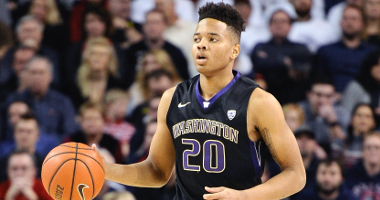

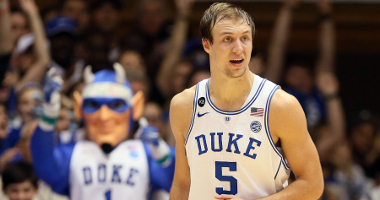

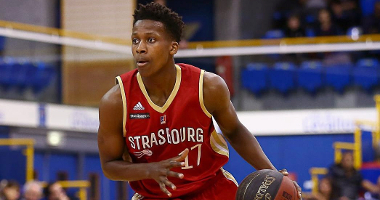
















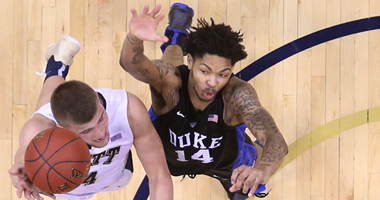














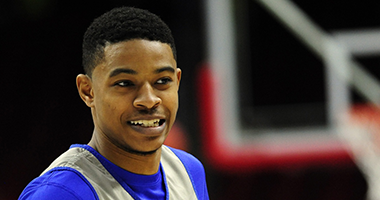









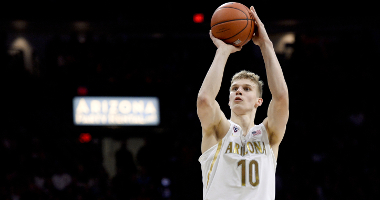
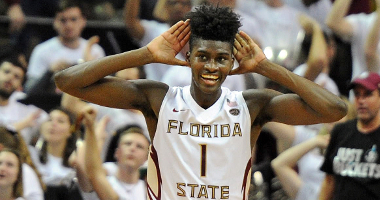

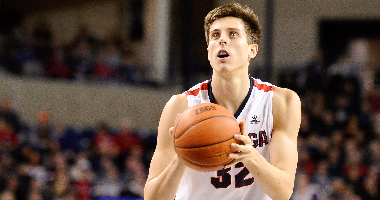

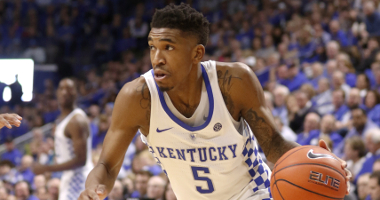

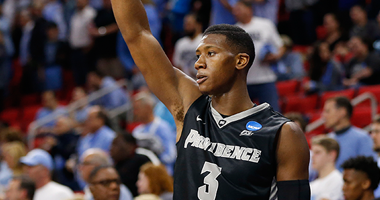


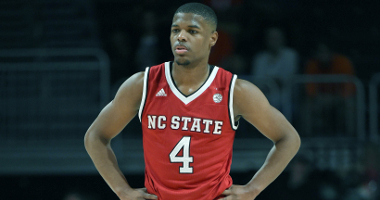

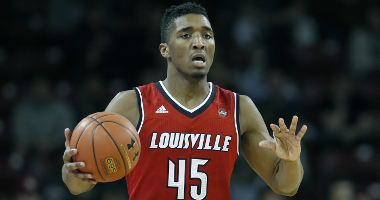






Comments